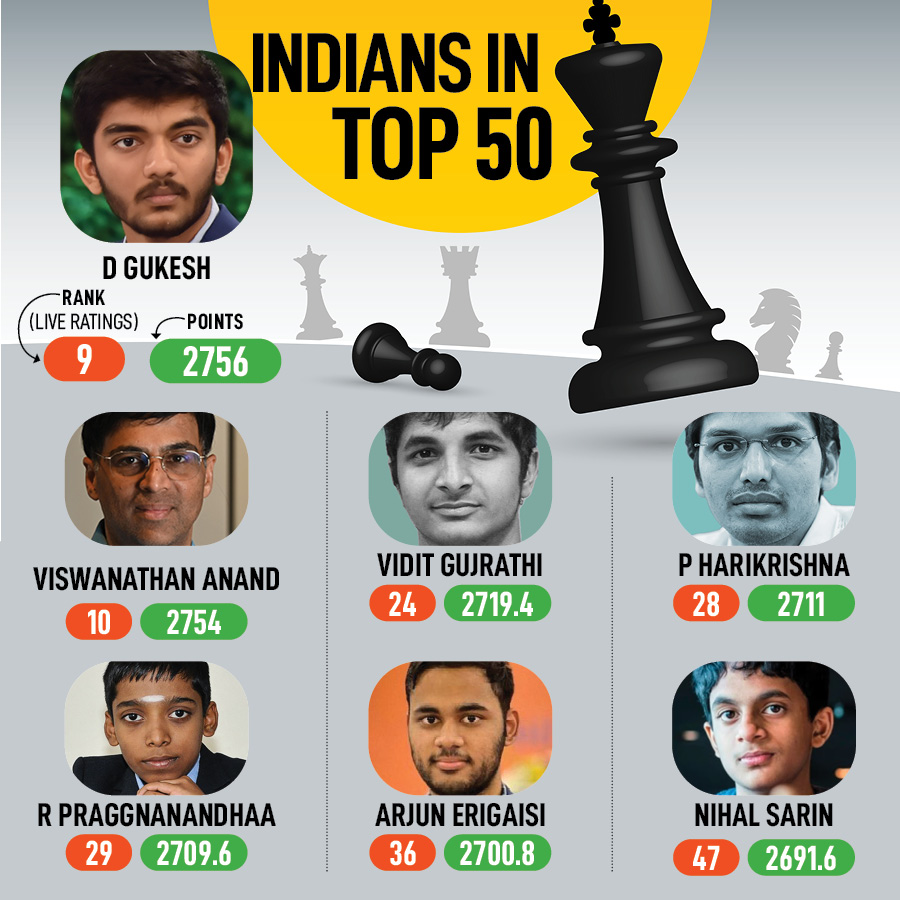The Rise of chess popularity in India

In the tapestry of chess history, India has woven a rich narrative, transitioning from an emerging chess nation to a powerhouse in the global arena. A pivotal figure in this journey is the iconic Viswanathan Anand, whose influence has not only shaped the landscape of Indian chess but has also paved the way for a new generation of prodigious talents, including the likes of Gukesh D and Praggnanandhaa R.
1. The Anand Legacy:
Viswanathan Anand’s strong mark on Indian chess transcends his five World Chess Championship titles. Anand’s ascendancy to chess excellence in the early 2000s not only inspired countless enthusiasts but also laid the foundation for a structured and ambitious chess infrastructure in India. His enduring legacy is marked not just by victories but by the growth and development of chess across the subcontinent.He became a national hero after winning the world champion title putting India on the map of chess!
2. Chess as a Cultural Phenomenon:
Anand’s triumphs catalyzed a cultural shift, transforming chess from a niche pursuit to a mainstream phenomenon in India. The nation witnessed a surge in chess clubs, school programs, and regional tournaments, reflecting a broader societal acceptance and appreciation for the game. Anand’s journey became a beacon for aspiring players, proving that from the chessboard of Chennai, one could conquer the world.
Many young prodgies emerged from india recently due to the influence of Anand. Hikaru Nakamura in an interview about chess called Anand " Chess God" due to the unbelieveable effect he had on the indian chess!

3. The Rise of Gukesh D:
As the chess renaissance in India unfolded, Gukesh D emerged as a prodigious talent. Gukesh, hailing from Chennai, achieved the title of Grandmaster at the age of 12 in 2019, making him one of the youngest Grandmasters in the history of the game. His meteoric rise is a testament to not only his innate skill but also the nurturing chess ecosystem that has evolved in India.
Gukesh’s style is characterized by a potent blend of tactical prowess and strategic understanding. His achievements in various age-group categories underscore his versatility and dominance. Gukesh’s success serves as a beacon for other young talents, illustrating the potential for greatness within the burgeoning chess community of India.
4. The Phenomenon of Praggnanandhaa R:
In the same breath as Gukesh, another chess prodigy has been making waves on the international scene the absolute talent Praggnanandhaa R. Hailing from Chennai, Praggnanandhaa became the world’s second-youngest Grandmaster in history, achieving the title at the age of 12 in 2018. His journey to the upper echelons of chess mirrors the commitment, dedication, and support that have become integral to the Indian chess narrative.
Praggnanandhaa’s playing style is characterized by audacity and fearlessness. His victories over seasoned grandmasters at a young age have made headlines globally, establishing him as a force to be reckoned with in the chess world. His achievements underscore the depth of talent emerging from India, signaling a bright future for the nation on the international chess stage.
5. Youth Development Programs and Academies:
Central to the success of these rising stars are the structured youth development programs and chess academies that have proliferated across the country. The Anand effect extends beyond individual achievements to the broader chess ecosystem. The Westbridge Anand Chess Academy, among other initiatives, has played a pivotal role in identifying and nurturing young talents, providing them with the necessary tools to navigate the complexities of the game.
These programs emphasize a holistic approach, combining technical proficiency with mental resilience and strategic thinking. The emphasis on early development, coupled with mentorship from experienced coaches, has created a pipeline of talent that is redefining India’s standing in the chess world.
6. Success on the Global Stage:
Gukesh D and Praggnanandhaa R are not anomalies; they are representative of a broader trend where Indian chess players are consistently proving their mettle on the global stage. Indian players are securing victories in prestigious tournaments, challenging the established order, and contributing to the dynamic evolution of chess.
The success of the rising stars, coupled with the sustained brilliance of Viswanathan Anand, reinforces India’s reputation as a powerhouse in international chess. The nation’s players, old and young alike, are becoming synonymous with strategic innovation, tactical brilliance, and unwavering determination.
Conclusion:
India’s rise as a chess superpower is a story of evolution, fueled by the pioneering spirit of Viswanathan Anand and embraced by a new generation of grandmasters like Gukesh D and Praggnanandhaa R. The chess renaissance in India is not just a statistical anomaly but a cultural shift, symbolizing the transformative power of the game.
As the chess narrative unfolds in India, it’s evident that the best moves are yet to be played. The nation’s young talents, guided by the legacy of Anand and supported by a robust infrastructure, are poised to continue making waves on the global stage. The checkered board, once a niche fascination, has become a symbol of aspiration for countless young minds across the nation, marking India’s ascent as a rising star in the world of chess.